PSYC 2: Biological Foundations -
Fall 2012 - Professor Claffey
Notes: Synapse
History:
10/26/12 - changed formatting
10/4/12 - original version
Structure & Function
(This content is covered in Sinjin's presentation, see link in
calendar)
Neurotransmitters
Synaptic cleft
Post-synaptic potential
Excitation
Inhibition
Receptors
Ionotropic
Metabotropic
Neurotransmitter Sequence
(This content is covered in Sinjin's presentation, see link in
calendar)
1. Neurotransmitter synthesis
Small neurotransmitters
Large neurotransmitters
2. Exocytosis (neurotransmitter release)
3. Receptor interaction
Ionotropic receptors
Metabotropic receptors
4. Removal from synapse
Diffusion
Reuptake
Enzymatic degradation (breakdown)
Integration
A depolarization from one neuron is typically not enough to trigger
an action potential
Each neuron can receive signals from 1000s of synapses
Integration - combining many different signals to determine if an
action potential occurs
Temporal Integration
depolarizations that _________________________
may combine to cause ________________
Spatial Integration
depolarizations that __________________________
may combine...
Types of neurotransmitters
More than 100 identified neurotransmitter substances
________________ (small NT)
Molecules that make up proteins, found in our
diet
Most common neurotransmitters for fast acting,
directed synapses
________________ - main excitatory transmitter,
sensory & learning systems
________________ - main inhibitory transmitter
________________ (small NT)
Not a typical synapse NT
Release NT broadly throughout brain
Produced by cells in the brain stem
More likely to modify "global" function/state of
the brain
________________ - motor function and reward
________________ - (adrenaline, adrenergic)
________________- (nor-adrenaline,
nor-adrenergic) - brain arousal, mood, hunger, sleep
________________ - mood, temperature, aggression,
sleep
________________ (small NT)
Neurons are called cholinergic
Location
Neuromuscular junction
Throughout autonomic system
(parts of our nervous system NOT under voluntary control)
In parts of central nervous
system - cortical arousal, memory
Unconventional NTs (small NT)
Don't have to know
________________ (large NT)
Full proteins made up of many amino acids
>100 neuropeptides
Many have role as both neurotransmitter and
hormone
Drug action
Antagonist - decrease the effect of a neurotransmitter
Agonist - increase the effect of a neurotransmitter
Receptor agonists
Nicotine - stimulates acetylcholine receptors
Receptor blockers
Botox - nicotinic receptor antagonist
Reuptake blockers
Cocaine, amphetamines - impairs dopamine
transporter
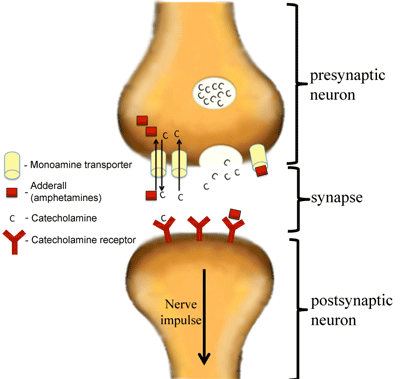
Source: http://www-scf.usc.edu/~uscience/adderall_abuse.html
Gap Junctions
A direct connection between the cytosol (internal fluid) of two
cells
Faster than a chemical synapse
Doesn't require neurotransmitters
Not common in the brain
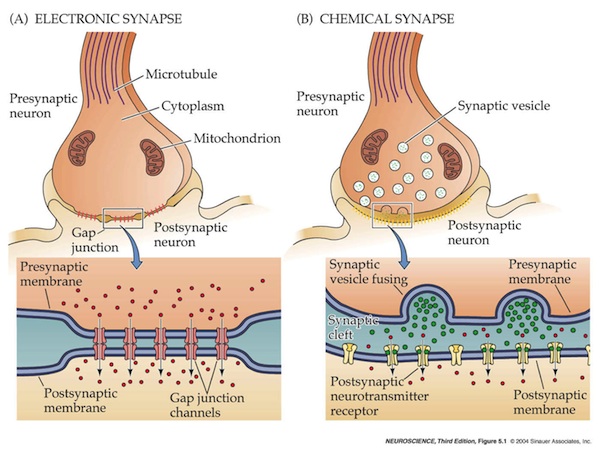
Synaptic Plasticity
Changes in connections between neurons can produce changes in
behavior
"Neurons that fire together, wire together"
- paraphrasing Donald Hebb's 1949 theory of memory
Long Term Potentiation (LTP)
Typically studied in hippocampus
Process
- Put a STIMULATING electrode in the upstream (presynaptic)
neuron
- Put a RECORDING electrode in the downstream (post-synaptic)
neuron
- Record the reaction of the downstream neuron to a single
upstream stimulation
- Provide high-frequency, high-intensity stimulation to upstream
neuron (no measurement)
- Record the reaction of the downstream neuron to a single
upstream stimulation
Increased response in downstream neuron
Can be measured months later
Requires pre- and post- synaptic neurons to both have action
potentials
Induction
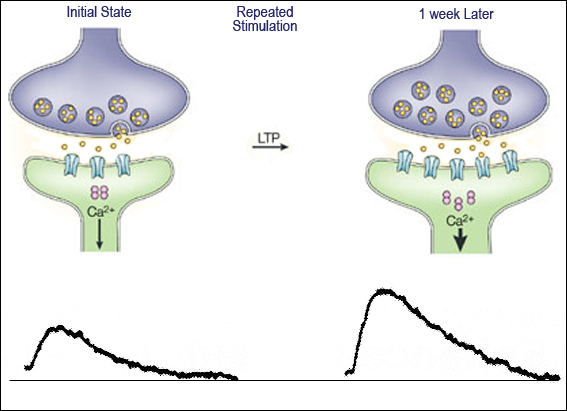
Source:
http://employees.csbsju.edu/ltennison/PSYC340/learning.htm
LTP Requires ________ receptors
NMDA receptors allow Ca++ to enter
Ca++ causes changes in cell
functioning, such as creating new receptors
NMDA receptors are excited by _____________
and require post-synaptic
neuron to already be partially ______________
NMDA are able to detect the co-occurrence of
______________________ and ______________________ depolarization
Maintenance/Expression
The post-synaptic neuron does not strengthen connections with all
pre-synaptic neurons,
only across synpases that were depolarized
LTP requires protein synthesis
Neuron is making new ____________ to "build"
or strengthen the synapse
Relation to behavior
LTP is a model for memory, and memory is probably "like" LTP,
but LTP is an artificial technique done in a
laboratory setting
Rats learning a maze task fail to learn if NMDA receptors are
blocked (Morris et al 1986)
Rats learning an avoidance task produce new AMPA receptors, the
same receptors produced by LTP. Also, in vitro synapse that were
potentiated during training could not be further induced by LTP.
(Whitlock et al, 2006)
Animals undergoing fear conditioning show evidence of LTP-like
processes (Rogan et al, 1997)
Learning in a Sea Slug
Aplysia
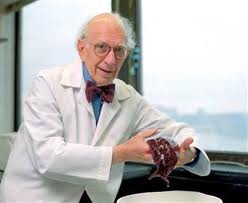
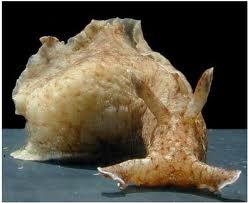
A sea slug with 200 neurons studied by Eric Kandel
Has a gill which it will withdraw if its siphon is touched
These are two examples of synaptic changes that explain an animal's
behavior
Habituation
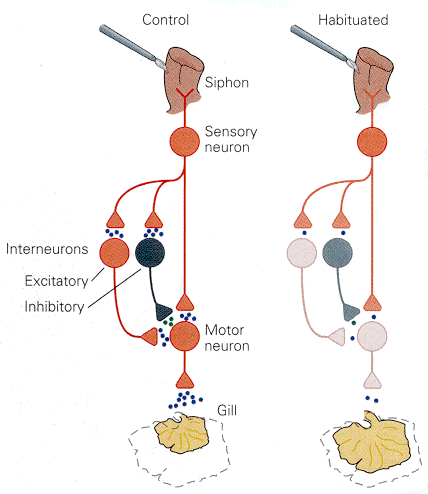
Source: http://michaeldmann.net/mann18.html
If the siphon is repeatedly touched, the gill withdrawal reflex
disappears
With repeated activation, the neurons contain less dopamine and
release less dopamine each time
Eventually gill withdrawal stops
A "short term" change in synaptic activity that does NOT
require building new proteins
Sensitization
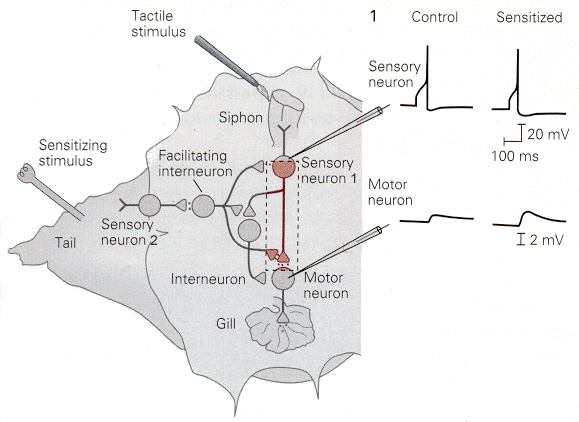
Source: http://michaeldmann.net/mann18.html
If the tail is shocked at the same time the siphon is touched:
Gill is more vigorously withdrawn to a siphon
touch
Siphon has become "more sensitive"
Facilitating interneuron releases serotonin onto sensory neuron
Causes the sensory neuron to release more
neurotransmitter when the siphon is stimulated
Causes motor neuron to react more vigorously
A "short term" change in synaptic activity that does NOT
require building new proteins
(can be made "long term" with more training)
Copyright 2012 - Michael Claffey






